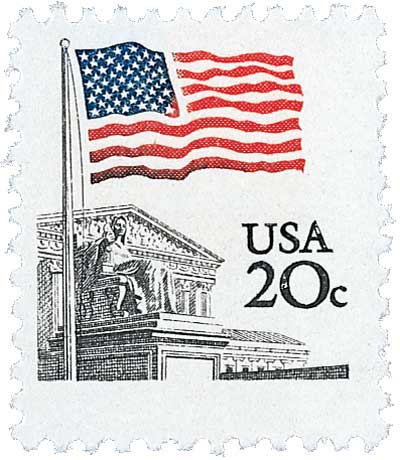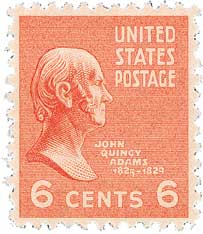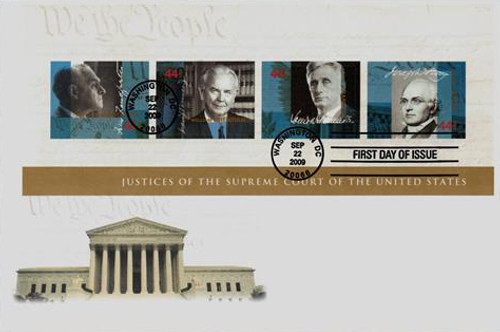
# 4422d - 2009 44c Supreme Court Justices: Joseph Story
Supreme Court Justices
Issue Date: September 22, 2009
City: Washington, DC
In the spring of 1787, the Founding Fathers gathered in Philadelphia to write a new constitution. One hundred days later, tears streamed down Benjamin Franklin’s face as he put his name to the 4,400-word document that gave birth to the United States of America.
The U.S. Constitution is the shortest document of its kind and has several areas that are subject to interpretation. Questions of law regarding its meaning fall within the province of the Justices of the Supreme Court of the United States. Their historic decisions on civil liberties, industry, and the balance of interests between individuals and government touch the lives of Americans in countless ways every day.
Joseph Story (1779-1845) was only 32 years old when James Madison appointed him to the U.S. Supreme Court in 1811. The youngest person ever named to the high court, Story helped expand the scope of the Supreme Court.
Justice Story believed it was the job of federal judges to protect against state laws that conflicted with the U.S. Constitution. He reasoned that if state courts had the power to interpret the Constitution, there would be as many versions of the Constitution as there were states. Following this philosophy, Story’s opinion in Martin v. Hunter’s Lessee established the supremacy of the Supreme Court over state courts on questions of federal law.
However, Story’s most famous court opinion was U.S. v. Amistad in 1841. When a Spanish ship carrying Africans was captured off the coast of Long Island, Spain demanded the return of their property. Justice Story ruled that since Spain had outlawed the international slave trade, the Africans were not slaves. Rather, they were unlawfully kidnapped and entitled to their freedom.
During Joseph Story’s time on the Supreme Court, he helped define the practice of judicial review and established the “balance of power” within the federal government intended by the Founding Fathers.
Court Issues Ruling In The Amistad Case

On March 9, 1841, the U.S. Supreme Court issued its final ruling the case of United States v. Schooner Amistad.
In 1839, a group of Africans were kidnapped from Sierra Leone, taken aboard a boat, and forced into slavery. On the trip from Havana, Cuba, to Puerto Principe, Cuba, they rebelled and assumed control of the boat, the Amistad. They demanded the ship’s navigator take them back to Africa, but instead he tricked them and took them to the United States.
Upon reaching the U.S., Naval Lieutenant Thomas R. Gedney took who he believed to be slaves and the ship to Connecticut to claim salvage rights on the ship and all its contents. What followed was a lengthy court battle over who had the rights to the ship and everything on board, including the kidnapped Africans.

A court case began which carried serious political consequences, both within the United States and internationally. The South was enraged as lower courts ruled that the Africans had been illegally kidnapped, as that had an impact on slaves in America. Spanish Queen Isabella II – not even a teenager yet – made wild demands upon U.S. President Martin Van Buren to return the Africans as Spanish property.

Former President John Quincy Adams, a fervent abolitionist, jumped at the opportunity to defend kidnapped Africans. The U.S. government held that since they had mutinied and killed the crew, they should be deported. However, Adams argued that the Africans were illegally forced into the slave trade and had the legal right to do whatever necessary to ensure their freedom.
Adams argued that the numerous claims on the Africans were not relevant, as these were people (not property) and they were never slaves to begin with. Adams spoke for eight and a half hours, spiritedly defending their rights and discounting the claims of the opposition.

Many considered Adams fight to be an uphill battle. But in the end, the U.S. Supreme Court sided with Adams on March 9, 1841, with a 7-1 ruling in favor of the Africans. Associate Justice Joseph Story wrote in the opinion, “They are natives of Africa, and were kidnapped there, and were unlawfully transported.” It was a key statement that challenged the idea that slaves were property and not people. The Africans were freed and, with help of donations, returned home the following year.
The case proved influential in several successive U.S. laws and is considered by some to be the most important slavery related case prior to the Dred Scott decision.
Click here for more about the case.
Supreme Court Justices
Issue Date: September 22, 2009
City: Washington, DC
In the spring of 1787, the Founding Fathers gathered in Philadelphia to write a new constitution. One hundred days later, tears streamed down Benjamin Franklin’s face as he put his name to the 4,400-word document that gave birth to the United States of America.
The U.S. Constitution is the shortest document of its kind and has several areas that are subject to interpretation. Questions of law regarding its meaning fall within the province of the Justices of the Supreme Court of the United States. Their historic decisions on civil liberties, industry, and the balance of interests between individuals and government touch the lives of Americans in countless ways every day.
Joseph Story (1779-1845) was only 32 years old when James Madison appointed him to the U.S. Supreme Court in 1811. The youngest person ever named to the high court, Story helped expand the scope of the Supreme Court.
Justice Story believed it was the job of federal judges to protect against state laws that conflicted with the U.S. Constitution. He reasoned that if state courts had the power to interpret the Constitution, there would be as many versions of the Constitution as there were states. Following this philosophy, Story’s opinion in Martin v. Hunter’s Lessee established the supremacy of the Supreme Court over state courts on questions of federal law.
However, Story’s most famous court opinion was U.S. v. Amistad in 1841. When a Spanish ship carrying Africans was captured off the coast of Long Island, Spain demanded the return of their property. Justice Story ruled that since Spain had outlawed the international slave trade, the Africans were not slaves. Rather, they were unlawfully kidnapped and entitled to their freedom.
During Joseph Story’s time on the Supreme Court, he helped define the practice of judicial review and established the “balance of power” within the federal government intended by the Founding Fathers.
Court Issues Ruling In The Amistad Case

On March 9, 1841, the U.S. Supreme Court issued its final ruling the case of United States v. Schooner Amistad.
In 1839, a group of Africans were kidnapped from Sierra Leone, taken aboard a boat, and forced into slavery. On the trip from Havana, Cuba, to Puerto Principe, Cuba, they rebelled and assumed control of the boat, the Amistad. They demanded the ship’s navigator take them back to Africa, but instead he tricked them and took them to the United States.
Upon reaching the U.S., Naval Lieutenant Thomas R. Gedney took who he believed to be slaves and the ship to Connecticut to claim salvage rights on the ship and all its contents. What followed was a lengthy court battle over who had the rights to the ship and everything on board, including the kidnapped Africans.

A court case began which carried serious political consequences, both within the United States and internationally. The South was enraged as lower courts ruled that the Africans had been illegally kidnapped, as that had an impact on slaves in America. Spanish Queen Isabella II – not even a teenager yet – made wild demands upon U.S. President Martin Van Buren to return the Africans as Spanish property.

Former President John Quincy Adams, a fervent abolitionist, jumped at the opportunity to defend kidnapped Africans. The U.S. government held that since they had mutinied and killed the crew, they should be deported. However, Adams argued that the Africans were illegally forced into the slave trade and had the legal right to do whatever necessary to ensure their freedom.
Adams argued that the numerous claims on the Africans were not relevant, as these were people (not property) and they were never slaves to begin with. Adams spoke for eight and a half hours, spiritedly defending their rights and discounting the claims of the opposition.

Many considered Adams fight to be an uphill battle. But in the end, the U.S. Supreme Court sided with Adams on March 9, 1841, with a 7-1 ruling in favor of the Africans. Associate Justice Joseph Story wrote in the opinion, “They are natives of Africa, and were kidnapped there, and were unlawfully transported.” It was a key statement that challenged the idea that slaves were property and not people. The Africans were freed and, with help of donations, returned home the following year.
The case proved influential in several successive U.S. laws and is considered by some to be the most important slavery related case prior to the Dred Scott decision.
Click here for more about the case.









